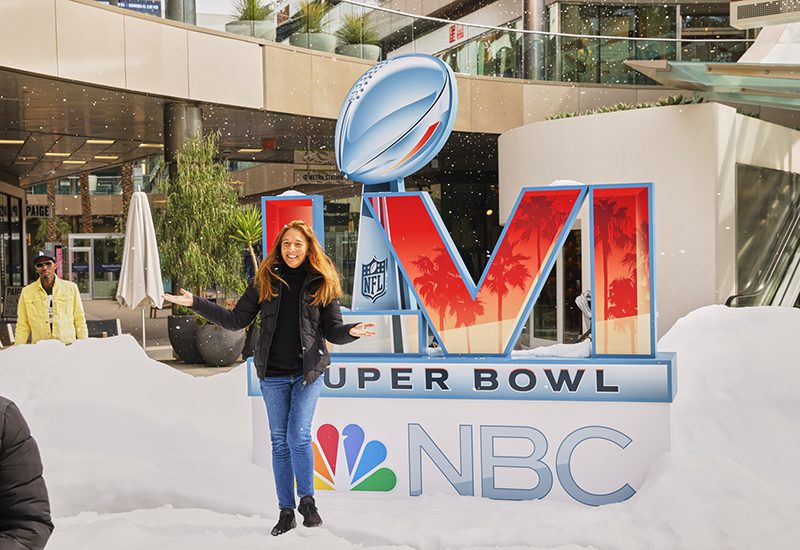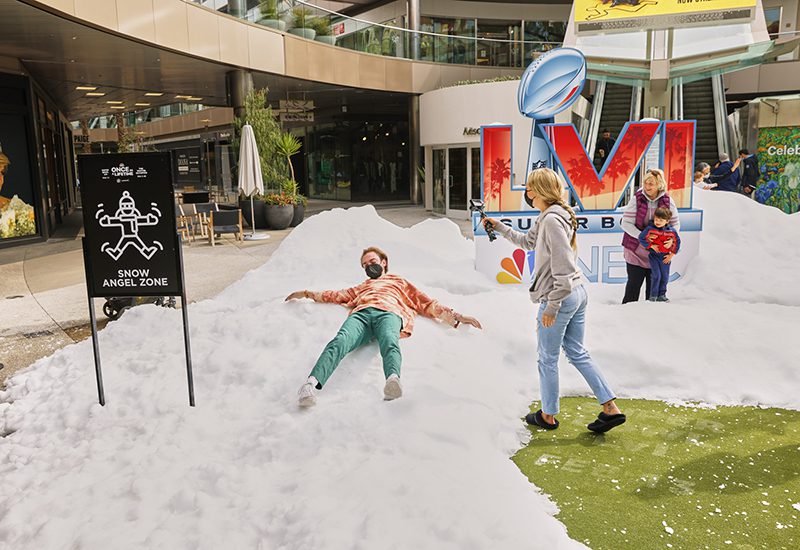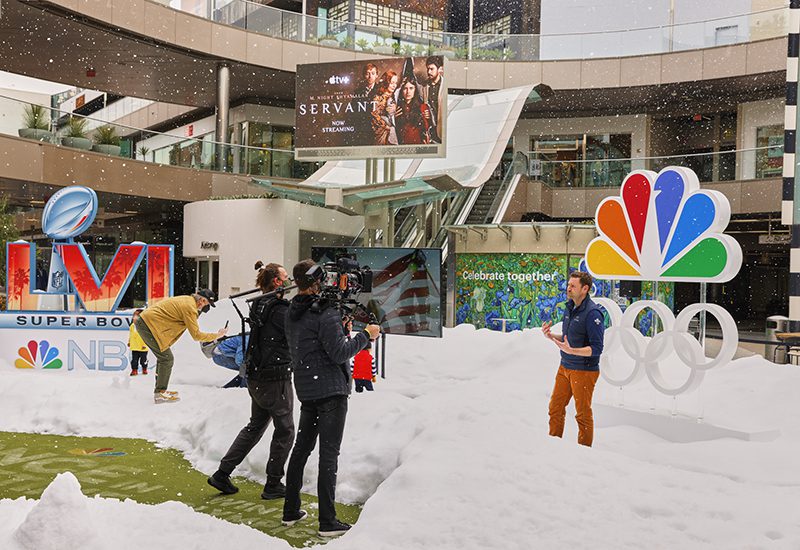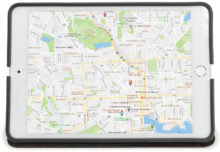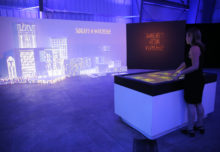It was a typical “72 and sunny” kind of day in Los Angeles on Jan. 31—unless you were passing through the main courtyard at Santa Monica Place. The L.A. hot spot was transformed into a winter wonderland with real-life snow on the ground, and snow intermittently falling from the sky. But this wasn’t a freak weather phenomenon; it was an intricate stunt delivered by NBC Sports and its production partner, GDX Studios. The activation was inspired by the overlapping of this year’s Super Bowl with the Winter Olympics, both of which were broadcast by the network. The rare convergence of the two tentpole events served as fuel for NBC’s “Once in a Lifetime” campaign, which included the L.A. snow day—a once-in-a-lifetime weather event for Angelenos, many of whom had never touched snow.
Thanks to a partnership with the “Today” show, the snow stunt was amplified nationally. Weatherman Al Roker reported live from Santa Monica Place in the wee hours of the morning (the show is set to East Coast time) as the snow fell, kicking off the experience before consumers were invited on-site. Local news stations and affiliates followed suit, reporting live from the winter landscape, and helping to scale the activation’s reach. Adding to the buzz around the stunt were snowstorms pounding the Midwest and Northeast regions of the U.S., making L.A.’s own snow day that much more relevant.
 More Winter Activation Ideas:
More Winter Activation Ideas:
- Five Steal-worthy Ideas for Cold Weather Outdoor Activations
- Peacock Pops Up an 18-Foot SnowSchrute to Highlight New Home of ‘The Office’
When the site opened up to the public, consumers were invited to make the most of the unique experience by partaking in snowball fights, making snow angels and snowmen and engaging in photo ops. They could also catch Super Bowl and Winter Olympics content featuring stories about athletes and teams on a 100-inch screen, which doubled as “Today’s” broadcast
monitor.
“That connective tissue for a consumer who is just maybe walking to get something at the mall and is able to experience a snow day in L.A. is something that we think leaves a different, lasting impression,” says Dan Palla, director-consumer engagement marketing at NBC Sports. “And I think that type of impression, and the connection to these events and to these brands as a once-in-a-lifetime experience was really crucial, not just strategically, but also for the emotional connection and brand affinity that we know is really important.”
The operations behind this kind of activation are complex, to say the least, and every element of the stunt’s build-up and tear-down was timed to the minute. So we caught up with GDX to get a detailed overview of the production process. Read below for a timeline of the program, from site visits to snow.
EARLY JANUARY: GDX conducts a series of Santa Monica Place site visits to ensure the stunt can be pulled off in that location. The team ensures the broadcast set can be oriented for maximum effect, the proper power sources are in order and that there are secure points on the multi-level mall’s rooftop to install snow cannons that create a snowfall effect.
JAN. 28: The snow cannons are installed and hidden on Santa Monica Place’s third-level roof well ahead of the stunt to keep the production schedule on track. Their snowfall capabilities are tested out.
JAN. 30, 8 P.M.: It’s go-time. Trucks roll up, and the team begins loading in tools and materials. Santa Monica Place closes at 7 p.m., so the crew waits an hour for the open-air mall to clear out before beginning work. A faux gridiron turf is the first activation element installed.
JAN. 30, 9 P.M.: Large props, like a custom Super Bowl LVI/Winter Olympics logo installation built by 760 Display, and audiovisual equipment, are unloaded and installed. At this time, the team has to coordinate ingress and egress access for trucks so that a vehicle doesn’t get blocked by the next truck when it’s time to depart.
JAN. 30, 10 P.M.: SnowMagic begins making snow and building the “winter” part of the wonderland. The team creates real-life snow to cover the ground and uses a water-based technology akin to a bubble-making machine to produce flakes that fall from the sky. The result is 1,600-square-feet of snow, stacked up to four feet high in some areas. The process takes nearly five hours to complete and requires eight refrigerator trucks loaded with 40 tons of ice blocks.
JAN. 31, 3 A.M.: “Today” crews load in their equipment and prepare for Roker’s broadcast. An NBC satellite truck and fiber optic technology are incorporated to ensure a smooth transmission. Filming takes place from 3:15-7 a.m.
JAN. 31, 7 A.M.: Teams completely refresh the footprint for the next two hours to prepare for its public debut.
JAN. 31, 10 A.M. TO 8 P.M.: Consumers are invited to interact with the snowscape. Brand ambassadors are on hand to take photos and reassure passersby that it’s OK to play in the snow. The scene, including the snow, is refreshed often and flakes fall every 20 to 30 minutes from the concealed cannons.
NIGHT OF JAN. 31: Crews load out, removing every trace of snow and leaving the site just as they found it.
This story appeared in the Spring 2022 issue


